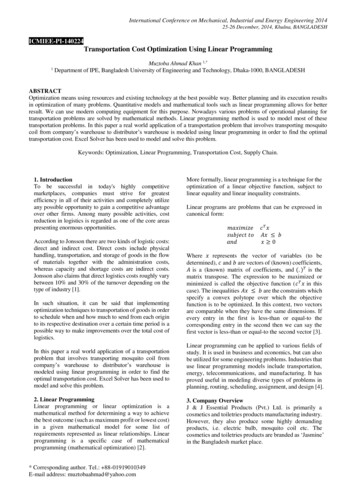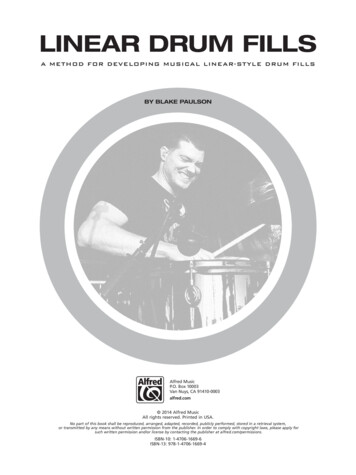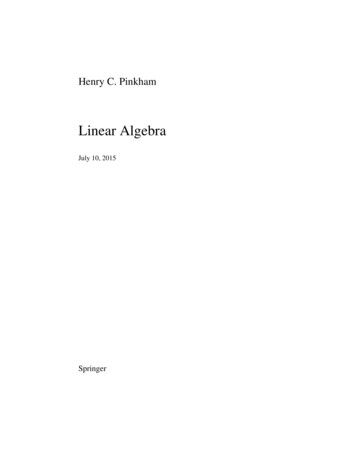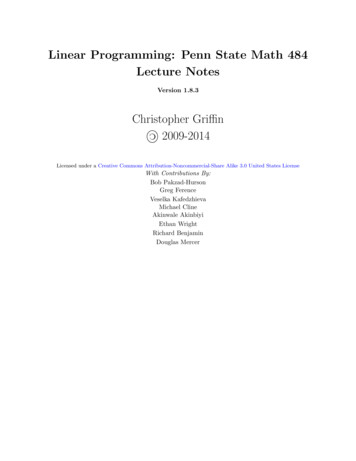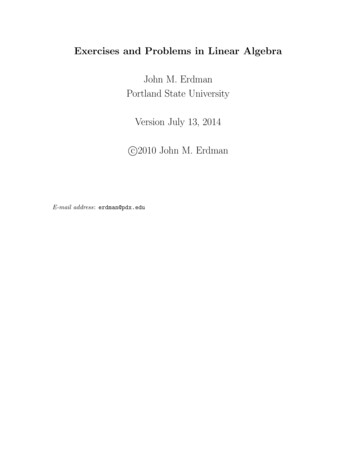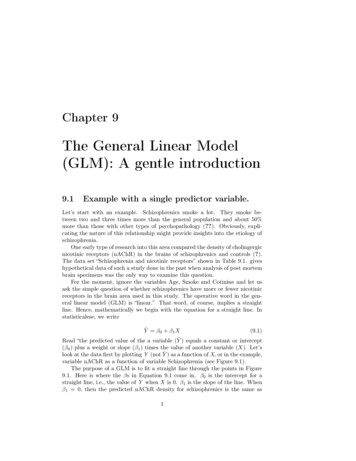
Transcription
Chapter 9The General Linear Model(GLM): A gentle introduction9.1Example with a single predictor variable.Let’s start with an example. Schizophrenics smoke a lot. They smoke between two and three times more than the general population and about 50%more than those with other types of psychopathology (?). Obviously, explicating the nature of this relationship might provide insights into the etiology ofschizophrenia.One early type of research into this area compared the density of cholingergicnicotinic receptors (nAChR) in the brains of schizophrenics and controls (?).The data set “Schizophrenia and nicotinic receptors” shown in Table 9.1. giveshypothetical data of such a study done in the past when analysis of post mortembrain specimens was the only way to examine this question.For the moment, ignore the variables Age, Smoke and Cotinine and let usask the simple question of whether schizophrenics have more or fewer nicotinicreceptors in the brain area used in this study. The operative word in the general linear model (GLM) is “linear.” That word, of course, implies a straightline. Hence, mathematically we begin with the equation for a straight line. Instatisticalese, we writeŶ β0 β1 X(9.1)Read “the predicted value of the a variable (Ŷ ) equals a constant or intercept(β0 ) plus a weight or slope (β1 ) times the value of another variable (X). Let’slook at the data first by plotting Y (not Ŷ ) as a function of X, or in the example,variable nAChR as a function of variable Schizophrenia (see Figure 9.1).The purpose of a GLM is to fit a straight line through the points in Figure9.1. Here is where the βs in Equation 9.1 come in. β0 is the intercept for astraight line, i.e., the value of Y when X is 0. β1 is the slope of the line. Whenβ1 0, then the predicted nAChR density for schizophrenics is the same as1
CHAPTER 9. THE GENERAL LINEAR MODEL (GLM): A GENTLE9.1. EXAMPLE WITH A SINGLE PREDICTOR VARIABLE.INTRODUCTIONTable 9.1: Data set on schizophrenia and brain density of nicotinic 12.4527.2017.0826.7719.5617.7326.3010.30
CHAPTER 9. THE GENERAL LINEAR MODEL (GLM): A GENTLEINTRODUCTION9.1. EXAMPLE WITH A SINGLE PREDICTOR VARIABLE.Figure 9.1: Number of nicotinic receptors (nAChR) as a function of diagnosis.that for controls. As the slope deviates from 0, in either a positive or negativedirection, then there is more and more predictability.At this point, you may rightly ask how one can have an intercept and a slopefor a variable that has values of “No” and “Yes.” We’ will see the answer later,but for the time being let us create a numeric variable called SzDummyCodethat has the numerical value of 1 for Schizophrenia “Yes” and 0 otherwise.1Running the GLM gives these estimates: β0 19.99 and β1 1.71. Hence,for controls, the value of X in Equation 9.1 is 0, so the predicted nAChRconcentration isŶ 19.99 1.71 0 19.99and for the schizophrenics in the sample,Ŷ 19.99 1.71 1 18.28One reason for calling the general linear model “general” is that it can handlean X that is not numerical as well as one that is numerical. Hence, there isno difference between performing a GLM analysis using Equation 9.1 with X isvariable Schizophrenia with values of “No” and “Yes” and performing one whereX is the numerical variable SzDummyCode with values of 0 and 1. Table 9.2gives the results of GLMs in which the X variable is the numeric SzDummyCode(top) and in which the X variable is the qualitative variable Schizophrenia.Notice that there are no differences in any value between the output for variable SzDummyCode and Schizophrenia. Notice also that there the bottom halfof the table labels the variable “SchizophreniaYes” and not simply “Schizophrenia.” This is a hint as to what is going on when the GLM handles a nonnumeric1 Dummycoding is described in Section X.X.3
CHAPTER 9. THE GENERAL LINEAR MODEL (GLM): A GENTLE9.2. EXAMPLE WITH MORE THAN ONE PREDICTORINTRODUCTIONVARIABLE.Table 9.2: GLM results using a numeric (SzDummyCode) and a nonnumeric(Schizophrenia) variable.Numeric variable 991-1.711St. Error1.6752.473t11.938-0.692p4E-11.496Nonnumeric variable mate19.991-1.711St. Error1.6752.473t11.938-0.692p4E-11.496X variable. All GLM programs change the nonnumeric variable into a numeric one so that they can solve the mathematical problem. After that is done,the GLM “translates” the numerical output back into the original categories.Hence, the “SchizophreniaYes” using the variable Schizophrenia signifies thatone should add -1.711 to the value of the intercept to get the predicted valuewhen the variable Schizophrenia “Yes.”(A cautionary aside: Different GLM programs use different mechanisms forconverting the categories in a nonnumeric variable into numbers. Also, a usercan specify how to perform the conversion. Thus, the values of the βs canbe different for different coding schemes for the same problem. The predictedvalues, however, for the groups will always remain the same).Finally, look at the p value for the effect. It is .496 and definitely nonsignificant. One might be tempted to conclude that there is no difference innAChR concentrations between schizophrenics and controls, but that would beunwise. To see why, we must combine substantive knowledge on neurosciencewith statistics.9.2Example with more than one predictor variable.Remember, schizophrenics smoke a lot. Most of you have already asked yourselfabout the effect of smoking on the nicotinic receptor density. Similarly, smoking is associated with early death, so any effect of age on nAChR concentrationmight also cloud the results. These are not trivial issues because there is evidence that the number of nicotinic receptors decrease with age (?) and that theyare upregulated by the use of nicotine (?). The increase in nAChR from smoking and early death might have masked the differences between schizophrenicsand controls in this hypothetical study.4
CHAPTER 9. THE GENERAL LINEAR MODEL (GLM): A GENTLEINTRODUCTION9.2. EXAMPLE WITH MORE THAN ONE PREDICTOR VARIABLE.Table 9.3: Results of the GLM predicting nAChR from Age and 295E-070.0070.211Ideally, one would like to have a control matched to each schizophrenic on ageof death and smoking status at or near death. The practicalities of research withbrain banks, however, make it difficult and expensive–perhaps even impossible–to pull that off. Smoking status at death is often not known, and even if it isknown, there is wide variability in the amount of nicotine intake among smokers.Indeed, the data on variable Smoke (was the person a smoker at or near death?)in Table 9.1 has so many unknowns as to make the variable useless. One way toaddress this issue is to measure brain cotinine, a metabolite of nicotine, becauseit has a longer half-life than nicotine.We now want to control for both age and cotinine levels. We could dividethe specimens into groups by categorizing variables Age and Cotinine, but thatapproach is not recommended. In fact, it is downright stupid. If we used a cutoffof 65 on age for “young” versus “old,” there would be no young schizophrenicswith low cotinine values, and we would be comparing groups of size four withthose of size two in other categories.A GLM approach, however, avoids this. Suppose that we want to controlfor Age. We just add a second X variable to the right-hand side of Equation9.1, orŶ β0 β1 X1 β2 X2(9.2)It is good practice to put any control variables into the equation before thevariable of interest so X1 denotes variable Age and X2 is, as before, SzDummyCode (or Schizophrenia). Instead of a two dimensional plot as in Figure 9.1, theproblem would now be visualized via a three dimensional plot. Variable nAChRwould be axis equivalent to the height of the plot while Age and Schizophreniawould be the width and depth dimensions. With a single predictor variable, thepredicted values form a straight line in a two-dimensional plot. With two predictor variables, the predicted nAChR levels form a plane in a three dimensionalplot. Figure 9.2 gives an example.From the prediction plane in the figure, age is associated with lower nAChRlevels. Although it is difficult to tell from the plot, there is also a downwardprojection of the plane suggesting a decrease in the brains of schizophrenics.Would controlling for age now reveal a significant difference between controlsand schizophrenics?Table 9.3 gives the results of the GLM that predicts nAChR from Age and thedummy code for schizophrenia. . It is helpful to write the prediction equation5
CHAPTER 9. THE GENERAL LINEAR MODEL (GLM): A GENTLE9.2. EXAMPLE WITH MORE THAN ONE PREDICTORINTRODUCTIONVARIABLE.Figure 9.2: A scatterplot with two predictor variables.twice, once for controls and the second time for schizophrenics: C 32.61 .18 AgenAChR SnAChR 32.61 .18 Age 2.7729.84 .18 AgeThere are two salient aspects about the concept of control in the GLM.The first, arbitrarily called predictive control here, is evident by plugging anysingle value of age into both of the equations. No matter what value of age,schizophrenics will always be predicted to have 2.77 units of nicotinic receptorsless than controls. Hence, we can use the following language to describe theseresults: “controlling for age, schizophrenics are predicted to have 2.77 fewerunits of nAChR than controls.”The second type of control may be called statistical control, and it appliesto the statistical significance of the results. From Table 9.3, the coefficient forage is significant while the coefficient for variable SzDummyCode is not. Thestatistics behind calculation of the p values are complicated, but their meaningis simple. For age, the meaning is equivalent to the following: “controlling fordiagnosis, does age predict nAChR better than chance?” The answer here is“Yes.”For diagnosis, the relevant question is “controlling for any age differencesbetween schizophrenics and controls, is the 2.77 unit difference between thetwo greater than chance?” Here, the answer is “No.” It is logical to hypothesizethat the excess early mortality associated with schizophrenia may have obscured6
CHAPTER 9. THE GENERAL LINEAR MODEL (GLM): A GENTLEINTRODUCTION9.2. EXAMPLE WITH MORE THAN ONE PREDICTOR VARIABLE.Table 9.4: Predicting nAChR from age, cotinine and ces in nAChR density between them and controls in the initial analysis.The current GLM gives no support to that idea.We now want to control for cotinine, so we enter that variable into the GLM.In “variable-ese” the equation is β0 β1 Age β2 Cotinine β3 SzDummyCodenAChRor in statisticalese,Ŷ β0 β1 X1 β2 X2 β3 X3Table 9.4 gives the results of this GLM.Once again, write the equation for controls and the one for schizophrenics: C 26.20 .12Age .08CotininenAChR SnAChR 26.20 .12Age .08Cotinine 5.7(1)20.50 .12Age .08CotinineNote again that if we substitute into both equations any single value for ageand any single value for cotinine, then we predict that schizophrenics will have5.7 fewer units of nAChr than controls. From Table 9.4, that difference is nowsignificant!The fact that all three variables in Table 9.4 are significant tells us that:1. increases in age (regardless of, or controlling for, cotinine and diagnosis)predict lower nAChR levels better than chance;2. that increases in cotinine (regardless of, or controlling for, age and diagnosis) predict higher nAChR levels better than chance;3. that an “increase” in diagnosis or the presence of schizophrenia (regardlessof, or controlling for, age and cotinine) predicts decreases nACHr densitybetter than chance.Why did we not find an association between schizophrenic an nAChR density in the first analysis? The answer is simple–schizophrenics smoke a lot.7
CHAPTER 9. THE GENERAL LINEAR MODEL (GLM): A GENTLE9.3. GLM TERMINOLOGYINTRODUCTIONSchizophrenics smoke more than controls. Because of the amount of missingdata for smoking status at death, the initial brain samples could not be adequately matched for this important variable. Consistent with previous evidence,nicotine up regulated acetylcholine nicotinic receptors and, of course, results inhigh levels of its metabolite cotinine. This up regulation masked the difference in nAChR density between schizophrenic and control brains in the initialanalysis.Hence, the conclusion of this exercise is that schizophrenia is associatedwith decreases in nAChR number. Note carefully that the operative word is“associated ”. Synonyms would be “correlated ” and “predicted.” Finally, notethat any real life analysis would start with the third GLM that used age, cotinineand diagnosis as predictors. The order of presentation for the GLMs above waspurely didactic.9.3GLM terminologyAs in the vocabulary for any system that has evolved over time, GLM terminology can be confusing. As statistical theory grew, it was realized that severaldifferent techniques could be combined into a single, general technique. Hence,the term general in GLM. Also, the advent of digital computers permitted themathematics behind the general approach to be implemented. Nevertheless, weare left with a legacy of terms derived from the old techniques as well as tablesand short cuts used in hand calculations.The first type of terminology applies to the variables in the GLM. Thevariable on the left hand side of the GLM equation (Y or nAChR in the example)is called the dependent, predicted, or response variable. The variables on theright side of the equation (the X s or Schizophrenia, Age, and Cotinine) are calledthe independent, predictor, or explanatory variables. Usually, these terms arepaired: dependent with independent, predicted with predictors, and responsewith explanatory.An independent, predictor or explanatory variable that is measured withnumbers is called a numeric or quantitative variable or a covariate. One that isnot numeric (or uses numbers to indicate groups) is called a factor.2 The specificgroups within a factor are termed the levels of that factor. For example, thefactor sex would have two levels–female and male.The three classic statistical procedures that comprise the GLM are: (1) theanalysis of variance or ANOVA; (2) the analysis of covariance or ANCOVA;and (3) regression. In ANOVA, all of the independent variables are factors(i.e., qualitative variables). An ANOVA with only one factor is called a onewayANOVA. An ANOVA with more than one factor is called a factorial ANOVA.Often a factorial ANOVA is described by the number of levels in the factors.For example, if the first factor has two levels and the second factor has threelevels, the model is called a “two by three” design or “two by three ANOVA.”2 Sometimesnonnumeric variables are called qualitative variables.8
CHAPTER 9. THE GENERAL LINEAR MODEL (GLM): A GENTLEINTRODUCTION9.4. THE MEANING OF THE BETASA regression is GLM in which all of the variables are quantitative. Whenthere is only one X or independent variable, the regression is called a simpleregression. When there are two or more X s, the regression is called a multipleregression.An ANCOVA is a GLM with at least one qualitative and at least one quantitative predictor. Hence, ANCOVA is synonymous with GLM. Most statisticianstoday eschew the term ANCOVA and use GLM.9.3.1Orthogonal and non orthogonal designsIn generic statisticalese, the word orthogonal is a synonym for uncorrelated.Like most jargon in science, it was probably developed for two reasons: (1) lendan air of respectability to statistics as a science; and (2) deliberately confuseanyone trying to learn the field. When all independent variables of a GLM areuncorrelated with one another, then the model is orthogonal. When at least onepair of independent variables are correlated, the design is non-orthogonal. If theGLM has at least one continuous independent variable, then always regard itas non-orthogonal3 . Hence, the term orthogonal only applies to classic ANOVA, i.e., when all independent variables are strictly categorical. An ANOVA isorthogonal when each cell contains the same number of observations. Thiscondition is also termed a balanced design.In an orthogonal design, there is one and only one mathematical way toestimate the parameters of the model and to perform the statistical tests. Innon-orthogonal designs, however, there is more than one way to compute thesestatistics, so the user must make some assumptions about the best way to interpret the results.Finally, orthogonality is not akin to falling off a cliff. A two by two ANOVAthat has eight rats in three of its cells but seven in the fourth is so close tobeing orthogonal that the different ways of estimating the sums of squares willall yield the same substantive results. Hence, most designs in experimentalneuroscience will be close to being orthogonal. The issue is much more salientfor certain types of observational research. A random sample of, say, alcoholicsor sociopaths will contain roughly three males for every female. Here, one mustbe very careful about which type of sums of squares to request and to interpretwhen a variable like gender is in the model. In general, the more correlatedthe independent variables are, the more care must be taken in interpreting theresults.9.4The meaning of the betasThe general equation for GLM isŶ β0 β1 X1 β2 X2 . . . βk Xk3 Thereare exceptions to this rule but they are beyond the scope of this book.9(9.3)
CHAPTER 9. THE GENERAL LINEAR MODEL (GLM): A GENTLE9.4. THE MEANING OF THE BETASINTRODUCTIONThe βs in a GLM are coefficients or weights assigned to the predictor variables, i.e. the X s on the right had side of the prediction equation. Here, let usexplore some properties of these coefficients.The first β, β0 , is a constant. That it, it is the same for every observationregardless of any values on any of the X s. In geometrical terms, β0 is anintercept. Examine Equation 9.3 and let all of the X s equal 0. β0 is thepredicted value of Y when all of the X s equal 0. In terms of our example, itwould be the predicted nAChr density for neonatal controls (age is 0) with nobrain cotinine. (This prediction, however, is not sensible because it extends farbeyond the age range of the observed data, See Section X.X).The other βs are all associated with a variable. Because the variable is multiplied by the β, the β is a “weight” that determines how much the X contributesto prediction. If β 0, then the associated variable does not predict individualdifferences in Y (once again, with the proviso that we are controlling for allthe other variables). As an example, suppose that the β for age had been 0 inthe nicotinic receptor data. Then if we picked a subject with a given diagnosisand cotinine value, then changing age would make no difference in the predictednAChR level for that individual.In more specific terms, a β gives the predicted change in Y for a one unitchange in the X, keeping everything else constant. There is a very simple proofof this interpretation. Assume GLM equation of the form of Equation 9.3 andconcentrate on the ith X. We can write this equation asŶ0 . . . βi Xi(9.4)where the ellipses (. . .) denote “everything else in the equation that is keptconstant.” Now change the value of Xi from Xi to (Xi 1). The predictedvalue is nowŶ1 . . . βi (Xi 1)(9.5)Subtracting Equation for Ŷ0 from that for Ŷ1 from X givesŶ1 Ŷ0 βi (Xi 1) βi Xi βiA β gives the predicted change in Y for a one unit increase in X.Hence, the β for age (-.12) informs us that a one year increase in age isassociated with a decrease of -.12 units of brain nAChR. The β for cotinine tellsus that a one unit increase in cotinine predicts .08 units of increase in nAChR.Finally, an increase in one unit of diagnosis (in effect, a change from control toschizophrenia) predicts -5.7 units decrease in nAChR.Note carefully that the actual magnitude of a βs is a function of the unitsof measurement of its X. Suppose X was measured in milligrams. The β wouldgive the predicted change in Ŷ for a one milligram increase in X. If we changed10
CHAPTER 9. THE GENERAL LINEAR MODEL (GLM): A GENTLEINTRODUCTION9.4. THE MEANING OF THE BETASthe scale of X from milligrams to micrograms, then the β in the new equationwould give the change in Ŷ from a one microgram change in X. One can thereforearbitrarily make a β larger or smaller by simply changing the scale of its variable.This scale property of β leads to one of the most important cautions ininterpreting the results from a GLM: never compare the βs across variables todetermine the importance of the variables in prediction. In our example, theβ for a diagnosis of schizophrenia was -5.7 while the one for cotinine was .08.This does NOT imply that schizophrenia predicts nAChR much better thancotinine. Statistics other than the βs must be used to compare the effect sizesof the predictors.Never compare βs across variables to determine the importance of thevariables in prediction.9.4.1Standardized betasThe type of betas (βs) that we have been dealing with are often called raw orunstandardized regression or GLM coefficients. These terms derive from thefact that the predictor variable are expressed in raw or unstandardized units.In some cases, it is helpful to examine standardized regression coefficients.Suppose that we transformed the response variable, Y, to a new variable,ZY , with standard scores (see Section X.X). This means that the mean of ZY is0 and the variance of ZY is 1.0. Suppose that we also standardized each of thepredictor variables in the model to have means of 0 and standard deviations of1. The GLM equation isZŶ β0 β1 ZX1 β2 ZX2 . . . βk ZXk(9.6)The βs in this equation are called standardized coefficients. They are the GLMcoefficients from a model in which all variables have been standardized to havea mean of 0 and a standard deviation of 1.0.Standardized βs may be used to compare the relative predictive effectsof the independent variables.The interpretation of a standardized coefficient is the same as the one fora raw β but is expressed in terms of standard deviation units instead of rawunits. Hence, if β1 .09, then we predict that a one standard deviation changein variable X1 will result in a .09 standard deviation change in Y. Because all ofthe standardized predictor variables are the in the same units, standardized βsmay be compared to assess the predictive effect of one variable versus another.11
CHAPTER 9. THE GENERAL LINEAR MODEL (GLM): A GENTLE9.5. GLM AND CAUSALITYINTRODUCTIONThat is, if the standardized β1 .12 and standardized β2 .07, then X1 is abetter predictor of Y than X2 .9.5GLM and causalityIt is essential to stress that even though we speak of “dependency”, “explanations” and “effects,” causal interpretation of a GLM depends on the design ofthe study. True experiments (i.e., direct experimental manipulation, randomassignment, and strict control) permit inferences about causality. Given appropriate controls, if manipulation of variable A results in a change in the dependentvariable, then in some way, shape or form–directly or indirectly–A has a causalinfluence on the response. How that causal influence comes about, whether therelationship is necessary and/or sufficient, and the mechanism(s) of causalitycannot be answered by the statistical analysis of an experiment. Often, the answer to these questions depends on substantive issues coupled with the outcomeof the experiment.The smoking example is an excellent one for the discussion of causality.Cotinine predicts receptor density, but does it cause change in the numberof receptors? Probably not. The most likely casual agent is nicotine. Thenicotine up regulates receptors (?) and generates cotinine as a metabolite.Hence, cotinine is correlated with but has little causal effect on the number ofreceptors. Because of cotinine’s long half life (relative to nicotine), it works asa good control variable in the study.Technically, a GLM applied to non-experimental observational research doesnot permit inferences about causality. But one must be reasonable here becauseinterpretation of a GLM must be taken in the context of existing data andtheory. There has never been, and never will be, a true experiment examiningthe health consequences of cigarette smoking in humans. It would be unethical–in fact, downright cruel–to randomly assign young adolescents to a smokinggroup and a non-smoking control group, compelling the former to smoke and thelatter to abstain from cigarettes, until their health status could be ascertained40 years later. Yet, all the observational, epidemiological data on humans agreeso well with true experiments in animals and with mechanistic research into thecardiovascular and pulmonary effects of smoking that reasonable scientists infera causal connection.12
Chapter 9 The General Linear Model (GLM): A gentle introduction 9.1 Example with a single predictor variable.


